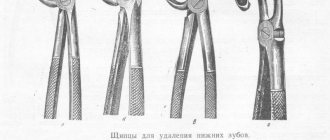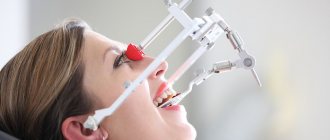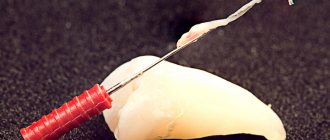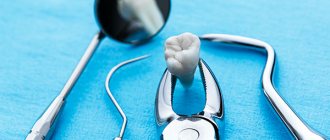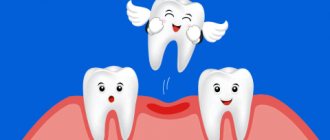From the age of six months, children begin to bother their parents with frequent tears. And the cause of these tears is toothache. After all, it is at this age that babies begin to erupt their baby teeth. And only at the age of six these baby teeth are replaced by permanent ones. Many parents who worry about their babies begin to wonder about various questions regarding the structure of teeth. After all, this is the key to unraveling why and under what circumstances pain occurs. In this article we will tell you Are there nerves in a child's baby teeth?.
When is a child's dental nerve removed?
The main indication for removing a nerve in a child’s tooth is pulpitis.
The disease is characterized by inflammation of the pulp, in the tissues of which there are vessels and the nerve itself. Pulpitis is accompanied by severe pain, deterioration of general condition and weakened immunity. There are risks of inflammation spreading and complications developing. Nerve inflammation is a complication of deep caries. Microbes that penetrate the dentin gradually infect the pulp, resulting in pulpitis. If treatment is not carried out in a timely manner, the pathological process begins to progress, gradually spreading to the soft tissues, and then to the jaw bone.
Removal of the nerve of baby teeth is not carried out only if the child has already begun the process of changing teeth, and a permanent tooth is growing in the coming months. An x-ray is taken to determine the prognosis. For such indications, tooth extraction is performed, since there is no risk of bite displacement.
Other indicators for the removal of baby teeth
- Caries, which can develop on the teeth of a two-year-old child. The resulting carious cavity can become a source for the spread of infection.
- Inflammation of the pulp, which occurs against the background of advanced caries.
- Periodonitis. Inflammation of the soft tissues around the tooth.
- This disease occurs in 3-5% of children.
- Trauma, as a result of which the tooth became loose and part of the tooth broke off. When a tooth is injured, the nerve bundle often ruptures. The pulp becomes unviable and must be removed.
What symptoms should you contact your dentist for?
Ideally, you should visit the dental clinic with your child every six months, and if signs of caries appear, treatment should begin immediately. But more often, parents turn to specialists when their child begins to suffer from severe toothache.
You should make an appointment with a dentist if your child exhibits the following symptoms:
- feeling of bursting and dull toothache;
- reduction of pain after eating hot food or during sleep;
- tooth sensitivity when eating;
- purulent odor from the mouth even after brushing your teeth;
- extensive carious cavity;
- other damage to the dental crown.
Pulpitis is characterized by rapid progression of the inflammatory process. If the nerve is removed at the initial stage, there will be no complications. In advanced cases, the pathological process can develop into a cystic or granulomatous form, or the infection begins to spread to the jaw bones or sinus tissue.
At what age should children have their baby teeth treated?
It is necessary to treat baby teeth at any age. In the first years, when baby teeth erupt, children are often limited in sweets and caries develops infrequently. At the age of 3-5 years, the situation becomes more complicated due to the fact that sweets become more accessible, and teeth brushing is often carried out irregularly and without due diligence.
At about 5-6 years old, baby teeth begin to be replaced by permanent ones. Usually this process is completed by the age of 14, although deviations in one direction or another are often encountered. It makes no sense for parents to wait for a certain time to start seriously taking care of their child’s teeth and taking him to the dentist. As we have already said, diseases of baby teeth can lead to their untimely loss and even cause damage to future permanent teeth. Decayed and prematurely lost baby teeth can cause problems with diction, prevent a child from chewing food normally, and cause digestive problems.
Therefore, from the very beginning, it is important to accustom children to regular oral hygiene, limit their insatiable love for sweets, and periodically take them for preventative visits to the dentist. In order for children not to be afraid of the dentist, it is important to choose a good clinic that employs pediatric dentists, with experience in treating primary teeth and attentive attitude towards young patients. If a child knows that a visit to the dentist does not necessarily mean that their teeth will be drilled, then they will be able to accept these regular visits with greater peace of mind, and their smile will always be flawless.
Methods for depulpation of the dental nerve
The method of removing a nerve in a baby tooth is determined by the stage of pulpitis and the degree of tissue damage. Treatment may involve partial or complete depulpation. The decision on the method of performing the procedure is made by the attending physician.
At the Martinka Children's Dental Clinic, dental nerve removal for children is performed using two methods.
- Chemical. The dentist puts a drug into the tooth cavity that “kills” the nerve. The drug does not affect healthy tissue. While the paste is in effect, a temporary filling is placed on the tooth. After 1–5 days, the filling is removed, and the pulp and nerve are removed. The method is only available for complete depulpation.
- Instrumental. The child is given anesthesia to relieve pain. The tooth is opened and the pulp is removed completely or partially using special instruments. At the end of the procedure, a medicinal paste with anti-inflammatory and antiseptic action is placed into the tooth cavity. A temporary filling is installed. After a few days, the drug is removed and a permanent filling is installed instead of a temporary filling.
If the inflammatory process has started, then upon completion of treatment, the dentist may prescribe a course of antibacterial drugs. Taking painkillers is permissible only as prescribed by a doctor.
How is the depulpation procedure performed?
As part of the treatment of pulpitis in dentistry, the nerve is most often killed and removed, although in some situations only partial depulpation is possible - here everything is strictly according to indications. The doctor will need an x-ray to assess the extent of the inflammation and determine a further course of action.
If it is decided to remove the pulp, then after all preparatory measures the depulpation procedure will be carried out. Under local anesthesia or additional sedation, the doctor will open the tooth, remove all affected tissue and remove the neurovascular bundle. If necessary, he will clean the canals and carry out additional antiseptic treatment. Next comes the filling stage. A control X-ray may be required so that the specialist can make sure that there are no foci of inflammation or possible mistakes made.
This treatment is carried out under anesthesia
In some cases, a temporary filling with a medicinal composition is fixed. After the set time has passed, the doctor will replace it with a permanent one. For filling, special mummifying compounds are used, which have an additional disinfecting effect and protect against infections. Only the material itself is not durable, but it should last until the bite changes.
The front or chewing tooth after depulpation is considered dead - it will not respond to temperature changes and acid-base influences. However, it will become even more fragile and may soon begin to break down.
Does it hurt or not?
The sensitivity of teeth is provided by a nerve that is located in the pulp tissue. For this reason, both the pathology itself and the process of its elimination presuppose the presence of pain.
Dentistry has ample opportunities for painless treatment of pulpitis. Anesthesia is used for this. Modern drugs are safe and do not pose a risk to the child’s health.
Methods of dental anesthesia.
- Local anesthesia. An anesthetic is injected into the soft tissues, eliminating any sensation for a certain period of time. To ensure that the child does not feel the injection, topical anesthesia is additionally used.
- Sedation. The method is also called “medicated sleep.” Pain relief is achieved by placing the child under a mild general anesthesia. To administer the anesthetic, intravenous and inhalation methods are used. The duration of anesthesia is from 10 minutes to 2 hours.
When treating young children under 5 years of age, dentists give preference to medicated sleep. It is difficult for a child to simultaneously cope with fear and maintain a calm position, which can complicate the procedure and cause tissue injury. Sedation allows you to eliminate psychological trauma and any painful sensations, as well as make the dentist’s work easier and speed up the treatment process.
In the future, people will not have wisdom teeth
It is now recognized that wisdom teeth are vestigial. This is the most problematic group of teeth, with many painful moments associated with it. When they erupt, a person may experience severe pain, inflammation, fever, and when all wisdom teeth appear, crowding of the dentition may begin. At the same time, they play almost no role in the process of experiencing food. Evolutionary changes lead to the fact that in modern times, wisdom teeth are increasingly not erupting in adults. It can be assumed that in the future they will disappear altogether.
Consequences of nerve removal
In the first 1–2 days after treatment, the tooth may hurt, but the intensity of the pain gradually decreases. To alleviate the condition, you can take analgesics recommended by a specialist. There are no other consequences of nerve removal.
Since pulpitis is most often caused by caries, during the treatment process the dentist removes the affected crown tissue. Restoring the integrity of the tooth is performed after removing the temporary filling. For correction, a filling material that does not contain toxic substances is used. In some cases, when the area of the carious cavity is too large and there is a risk of the filling falling out, it is recommended to install prostheses (stump or artificial crown.
Many parents mistakenly believe that depulpation implies the absence of a nerve in a permanent tooth. However, this is not at all true. Temporary and permanent teeth have separate systems and tissues that are not interconnected.
Martinka Children's and Adolescent Dentistry treats pulpitis by removing the nerve. Timely and correctly performed removal of the nerve of a baby tooth has no consequences. The integrity of the tooth is restored, and its functionality is preserved.
Possible complications
As a rule, there are no complications after depulpation. But this is provided that the parents showed the child to the doctor at the first signs of trouble, and the pulpitis is not advanced. Therefore, when talking about complications after nerve removal, we should mean clinical cases when a child came to the dentist with an already widespread inflammatory process or pulp necrosis.
In these cases, the greatest danger is posed by periodontal complications - granulomatous periodontitis (granuloma), cyst, inflammation of the periosteum or all tissues of the jaw bone. These consequences are only conditionally related to the professionalism of the dentist: severely destroyed tooth tissue and infected pulp are an extremely unfortunate combination that can lead to accidental perforation of the walls of the tooth or root, and provide microbes with a path for further spread.
Considering that in the first few years of a child’s life, his immune system is still unable to resist infection, the bacterial flora from the pulp can quickly spread to the paranasal sinuses, palatine and pharyngeal tonsils and other tissues and structures.
Parents who are interested in the question of whether it is painful to remove a nerve in a baby tooth need not worry: all manipulations are carried out under local anesthesia, developed specifically for young children, and does not cause complications.
Treatment of periodontitis in permanent teeth
Treatment of periodontitis in a permanent tooth involves removing the infection inside and outside the tooth, located in the ligament that holds the tooth.
Complaints. With this type of disease, complaints appear when biting on a tooth, a feeling of an “overgrown” tooth, pain in the gum next to the tooth, swelling and swelling of the gum, discharge of purulent contents from the tooth or from the gum. Signs of general intoxication of the body: fatigue, weakness, lethargy, temperature, enlarged regional lymph nodes.
Treatment method. Before dental treatment for periodontitis, local anesthesia is performed (if necessary). Demineralized tissue is removed from the carious cavity and access to the root canals is created for the purpose of high-quality mechanical, chemical and medicinal treatment. A medicinal paste is injected into the tooth canals for 7-10 days for the purpose of antiseptic and osteotropic effects, the treatment ends with the installation of a temporary filling. On the second visit, the medicinal paste is removed from the tooth, the root canals are filled with modern sealers (pastes) and fillers (gutta-percha pins) under X-ray control. After the treatment, the issue of restoring the crown part of the tooth is decided: a filling or a crown. Only a dentist, having assessed the condition of the tooth, will suggest one or another method of restoring the tooth.
Recommendations. Visit a dentist at least once every 6 months to examine the oral cavity in order to identify foci of inflammation, prevent complications and sanitation.
How are baby teeth different from molars?
Baby teeth appear at the age of six months. First, the central incisors erupt on the lower jaw, then on the upper jaw. By about 2.5 years old, the baby already has a full, white-toothed smile. His mouth contains 20 milk teeth, which will serve the child for several years.
After about six years, temporary teeth begin to be replaced by permanent teeth. When the baby brings the first “trophy” to his parents, it causes sincere joy and tenderness. And also the desire to carefully examine what the baby is holding in his fist. And while studying the tooth, parents can draw several wrong conclusions.
pixabay.co/
The first is that baby teeth have absolutely no roots. This impression is created because the root shoot of a fallen tooth is usually located on only one side, and sometimes it does not exist at all. In fact, primary incisors and molars, of course, have roots, but over time they become smaller.
This occurs in order to ensure a natural and painless process of changing the dentition. When the time comes to change the bite, the roots of the baby teeth gradually dissolve. And thanks to this, the indigenous ones “push out” their predecessors from the gums, taking their place.
The second incorrect conclusion may be related to the size of the tooth. It seems incredible that such a “baby” could have the same structure as an “adult” native.
“The structure of baby teeth is almost the same as permanent teeth,” comments Natalya Terentyeva. “They have roots, root and coronal pulp, root canals through which nerve fibers pass. Milk teeth differ from molars in that their enamel is weakly mineralized, which means it is more susceptible to destruction and the development of carious processes.”
Treatment of pulpitis of a permanent tooth
Child's complaints. Complaints are most often aching in nature, spontaneous or during meals.
Treatment method. It all depends on the state of the tooth roots: formed or unformed. If the roots of a permanent tooth have not yet formed, then a method of partial removal of the nerve is performed. The treatment method is described in detail in the section on the treatment of pulpitis of primary teeth. Hotels in Novosibirsk here, where This method of treatment allows the roots of the tooth to fully form. It is obligatory to have a dental check-up after 3 months, and then 2 times a year, with an X-ray examination.
If the roots of the teeth are formed, treatment is carried out with complete removal of the pulp. Under anesthesia, the pulp is removed, medicinal and mechanical treatment of the tooth canals is carried out, they are filled with sealer (paste) and filler (gutta-percha pins), then a temporary filling is performed. At the next visit, a permanent filling made of light-curing composite material is placed. An obligatory stage of treatment is an x-ray examination, which allows you to assess the condition of the tooth before, during and after treatment.
Recommendations. Visit your dentist every 4-6 months to prevent caries and its complications.



